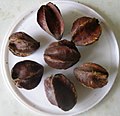| Terminalia arjuna | |
|---|---|
 | |
| Arjuna fruit | |
 | |
| Arjuna flowers with a Sykes's warbler | |
| Scientific classification | |
| Kingdom: | Plantae |
| Clade: | Tracheophytes |
| Clade: | Angiosperms |
| Clade: | Eudicots |
| Clade: | Rosids |
| Order: | Myrtales |
| Family: | Combretaceae |
| Genus: | Terminalia |
| Species: | T. arjuna |
| Binomial name | |
| Terminalia arjuna (Roxb.) Wight & Arn. | |
Terminalia arjuna is a tree of the genus Terminalia . It is commonly known as arjuna [1] or arjun tree in English. [2] It is used as a traditional medicinal plant. [3]






